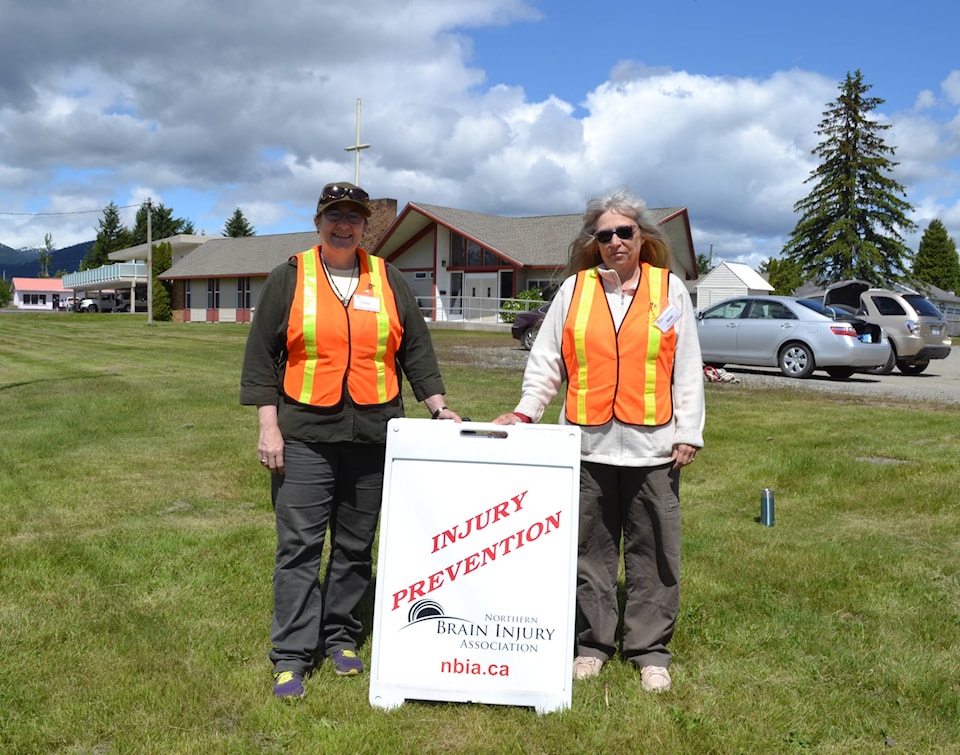A traffic survey over two days conducted in Kitimat by the Northern Brain Injury Association (NBIA) recorded 152 distracted drivers.
The surveys were conducted on June 8 and June 10 at the intersection of Kingfisher Ave. and Nalabila Blvd., and at the intersection of Haisla and Tsimshian boulevards on June 12.
NBIA northwest community case manager, Tekah Sabal, and volunteer Jean Nidd positioned themselves at the two intersections and counted the number of motorized vehicles, cyclists and pedestrians who travelled through the intersections in two, one-hour periods, in the morning and afternoon on two weekdays, and in two, one-hour periods on a weekend day.
The duo was on the lookout for a number of unsafe behaviours, including dangerous driving like - no seatbelts, unsafe driving, unsecured children - distracted driving, and unsafe pedestrian behaviours like - jaywalking, failing to look, unsafe crosswalk use - as well as cycling behaviours that could lead to injury, primarily brain injury like - riding without helmets, failing to stop and unsafe use.
Traffic was up with 4,065 vehicles counted this year compared to 3,096 vehicles counted in 2019. In one hour alone at the Kingfisher and Nalabila intersection, 757 vehicles were counted.
“136 drivers either failed to fully stop at the intersections, or had other traffic violations like speeding through, or out of the intersection, not using their turn signals, or coming into the intersection with a pedestrian in the crosswalk,” Sabal said.
Sabal believes that one of the biggest worries for distracted drivers is loose dogs in the vehicles or on the driver’s laps, the same as the 2019 survey.
“When it came to dogs, there would be one, two or even four in one instance, that we’re upfront with the driver, or enjoying the breeze out of rolled-down windows, some hung out as far as their chests. Others were loose in the open boxes of trucks. Any sudden stop, sharp turn, or instinctual trigger to bark or chase would result in tragedy,” Sabal said.
“One woman even had her chihuahua on her shoulder with the shoulder strap over the dog! It looked funny, but it wouldn’t be if she had to come to a sudden stop or got hit from behind.”
Another issue raised in the survey was pedestrians failing to look around before crossing intersections. Out of the 336 pedestrians counted, 90 of them failed to take precautions while crossing. That’s a decrease in pedestrian awareness compared to the 2019 survey, where only 14 out of the 136 counted didn’t look before crossing.
On the bright side, statistics showed that there were only 43 drivers not wearing their seatbelts while driving and 51 people riding non-motorized vehicles like - bicycles, scooters, skateboards - and only 14 of them were not wearing helmets. However, 51 per cent of those non-motorized vehicle riders did not use the intersection properly by not looking both ways, not waiting for the light to change or for vehicles to stop, or did not dismount their bikes or skateboards, before crossing safely.
“When I did see one cycling parent with their child who set a perfect example with safety precautions and rules at the Kingfisher intersection, I wanted to hug them, but Covid rules would not allow it,” Sabal said.
With 969 more vehicles counted this year compared to 2019, Sabal concluded that the Kitimat community may benefit from some more public education or awareness of the risks involved with distracted driving and with improper use of intersections.
Sabal also suggested that schools in the area might want to consider some targeted education for students about road safety on wheels and on foot.
The District of Kitimat funded and asked the NBIA to conduct the survey so it can compare the statistics that were found in 2019.
The NBIA already conducts the survey in five municipalities in northern B.C., making Kitimat the sixth municipality to do so.
“It’s part of the NBIA’s injury prevention mandate – the purpose is to get a snapshot of the road use behaviours of British Columbians in those cities in order to identify areas of need for more injury prevention education and to raise awareness for possible changes or improvements to the intersections,” added Sabal.
The data collected during the surveys are also made available to organizations like the RCMP, the ICBC, city councils, school districts and steering committees in those communities.
READ MORE: Traffic survey reveals disturbing statistic in Kitimat
